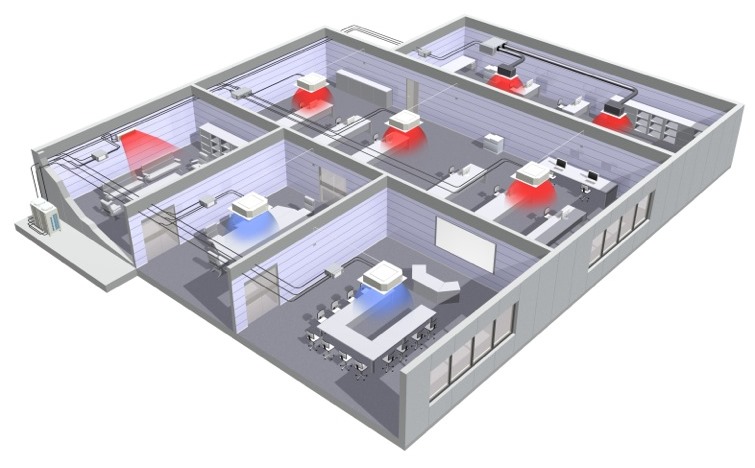Properly designed VRF systems offer many benefits including high performance, improved comfort, and a robust controls solution.
Paul Ehrlich,
Ira
Goldschmidt
& Angela Lewis
Building
Intelligence Group
|
September 2014 |
[an error occurred while processing this directive] |
|
Control of Variable Refrigerant Flow Systems
Properly designed VRF systems offer many benefits including high performance, improved comfort, and a robust controls solution. |
Paul Ehrlich,
Ira
Goldschmidt
& Angela Lewis September
Issue -
BAS Column
|
| Articles |
| Interviews |
| Releases |
| New Products |
| Reviews |
| [an error occurred while processing this directive] |
| Editorial |
| Events |
| Sponsors |
| Site Search |
| Newsletters |
| [an error occurred while processing this directive] |
| Archives |
| Past Issues |
| Home |
| Editors |
| eDucation |
| [an error occurred while processing this directive] |
| Training |
| Links |
| Software |
| Subscribe |
| [an error occurred while processing this directive] |
One of the most interesting new HVAC technologies is the use of
Variable Refrigerant Flow (VRF) systems. While the use of these
systems is fairly new in North America, they have been deployed in
other parts of the world for years. In fact in Asia, where the
concept was developed, they have been widely used for decades.
The concept of a VRF system is an extension of the ductless mini-split,
where you have a packaged condensing unit connected to an indoor fan
unit, which is mounted on the wall or in the ceiling grid. In a
VRF system, the same ductless indoor units are used but a single
outdoor condensing unit serves a group of them. The system can be
configured to provide cooling or heating (heat pump) at any unit as
well as heat recovery. The outdoor units typically have one or more
variable speed compressors and the ability to match the loads of the
interior units. System suppliers are starting to offer more and
more options with VRF including a variety of indoor units and outdoor
units that are either air or water-cooled.

Credit: Daikin Applied
As you can imagine there is a lot of technology required to make a VRF
system operate, including tightly integrated controls. The
suppliers generally sell this as a complete system that includes the
indoor and outdoor units as well as all of the required controls.
When specifying a system you can select various options for indoor unit
controllers (wired or wireless) as well as a central coordination
panel. The control sequences for the system are largely
pre-programmed by the manufacturer. While this may seem limiting,
we have observed remarkable efficiency from these systems, due in large
part to the close integration of the controls.
[an error occurred while processing this directive]
There are options, however, to integrate a VRF system into a Building
Automation System (BAS). Most suppliers offer an optional
controls gateway that will communicate using standard protocols such as
BACnet and LonTalk. The gateways provide the ability to monitor
the system and to do basic control such as changing space setpoints,
schedules, viewing faults, etc.
On most U.S. projects the use of a VRF system will require careful
attention to how ventilation air is introduced and managed. This
may mean the use of a dedicated outdoor air system (DOAS).
Overall controls design should focus not just on the integration of the
VRF system but also on coordination with the DOAS, and control of other
building systems including exhaust fans, lighting and other ancillary
loads.
Properly designed VRF systems offer many benefits including high
performance, improved comfort, and a robust controls solution.
Still careful attention needs to be placed as to how these systems will
either operate as a stand-alone system or ideally as part of an
integrated building automation system.
About the Authors
 Paul and Ira first
worked together on a series of ASHRAE projects
including the BACnet committee and Guideline 13 – Specifying DDC
Controls. The formation of Building Intelligence Group provided them
the ability to work together professionally providing assistance to
owners with the planning, design and development of Intelligent
Building Systems. Building Intelligence Group provides services for
clients worldwide including leading Universities, Corporations, and
Developers. More information can be found at
www.buildingintelligencegroup.com
We also invite you to contact
us directly at Paul@buildingintelligencegroup.com or
ira@buildingintelligencegroup.com
Paul and Ira first
worked together on a series of ASHRAE projects
including the BACnet committee and Guideline 13 – Specifying DDC
Controls. The formation of Building Intelligence Group provided them
the ability to work together professionally providing assistance to
owners with the planning, design and development of Intelligent
Building Systems. Building Intelligence Group provides services for
clients worldwide including leading Universities, Corporations, and
Developers. More information can be found at
www.buildingintelligencegroup.com
We also invite you to contact
us directly at Paul@buildingintelligencegroup.com or
ira@buildingintelligencegroup.com
[an error occurred while processing this directive]
[Click Banner To Learn More]
[Home Page] [The Automator] [About] [Subscribe ] [Contact Us]